May Is a Month of Grading
The Best Translated Book Award Finalists were announced earlier this week, and following up on my earlier post looking at the representation of various languages on the BTBA longlists, I thought I’d take a second to highlight the publishing houses (#NameThePublisher) that have historically done the best on the BTBA shortlists.
Although the award is in its eleventh year, we only have data in the Translation Database on the ten lists. (We had an award in 2008 honoring books from 2007, but started the Translation Database in January 2008.) Nevertheless, that covers 169 finalists, 18 winners, and 66 different publishers.
Before taking a look at the most successful presses, it’s worth taking a second to acknowledge that sixty-six different presses have had a book make it to the shortlist. Maybe I’m jaded, but that seems incredible. There are people out there who probably don’t believe that there are 66 different presses publishing translations.
Given the size of the shortlists though (10 titles for fiction, something approximating 5 for poetry), maybe this isn’t all that shocking. We designed the prize to highlight great works of international literature–some of which receive next to no attention when they’re published. So why not have a Big Shortlist to give these titles one more shot at finding readers, getting displayed at bookstores, catching the interest of a YouTube book vlogger. (Or whomever.)
When it comes to publishing a winning book . . . well, that’s a different story. Only 12 presses have had a book win, with only 3 having won more than once (New Directions, 4; Archipelago, 3; Phoneme Media 2).
Anyway, here’s the chart of everyone with 2+ finalists (or one that happened to also win):
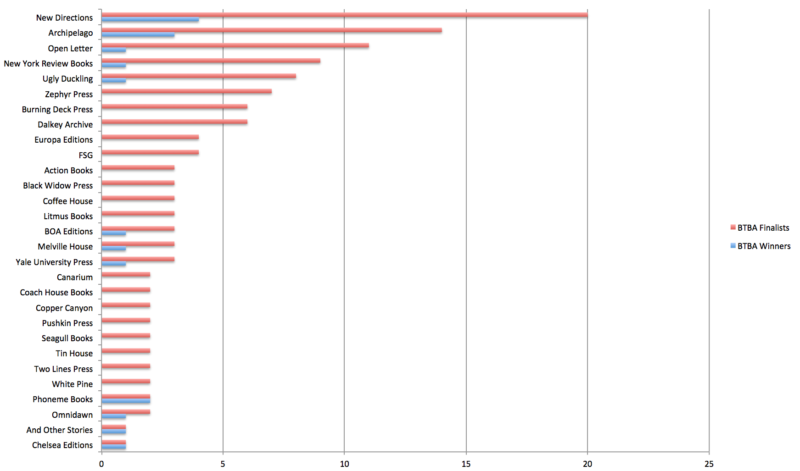
By itself, this is pretty interesting, but also potentially misleading. Over this time, how many eligible books has ND published versus BOA Editions? A: 138 vs. 20. So which press has been more impressive when it comes to BTBA representation? Obviously, overall reputation, market penetration, and author loyalty, all play a role in which presses are “more likely” to have books on this list. I would be far more surprised if ND wasn’t first.
That’s not to take away from their accomplishment though. They’ve published a healthy 11.8% of all BTBA finalists. That’s something. One of every 6.9 of their translations is shortlisted.
Let’s not overlook Archipelago though. They’ve published 77 eligible titles over this time, and 18% of them made the shortlist. That’s a title for every 5.5 translations they publish. Insane! And they’re only one behind New Directions in terms of total wins . . .
There are so many ways to slice this award . . . I think after the winners are announced, I’ll look back over all twenty winning titles and see what’s fared the best, and is most likely to be read in 2028.
* * *
It’s May, which means that most college students are about to leave behind the safety of their student loans for the “real world.” This is always a great moment for comfy CEOs of mid-level corporations to trot out a hundred-and-one clichés about the future, gumption, dream chasing, the need for fresh viewpoints, shaping the future, saving the world from mistakes of the past, and all that jazz.
It’s also a time in which almost every professor out there–especially those in the liberal arts?–complains about the burdens of grading papers and having to deal with “entitled” students. This line of complaints is an easy trap to fall into (I read 385 pages of student work last Monday and Tuesday to get grades in on time, which, poor me!), but one that’s never as compelling as the speaker seems to think it is.
But to go along with that end-of-the-school-year spirit, I thought I’d do some grading of my own–of jacket copy. In addition to writing about Cult X (totally don’t understand any of the reviews from other readers praising this book, but whatevs), I’m planning on writing about Allmen and the Dragonflies by Martin Suter and Ivory Pearl by Jean-Patrick Manchette later this week, and both Dag Solstad titles next week. So here are a handful of other translated May titles that sound interesting.
(Before getting started, please keep in mind I’m just trying to have some fun here. Every jacket copy is wonderful and open for jokes. And my grades are on a curve. If I had all the time, I would read all these books.)
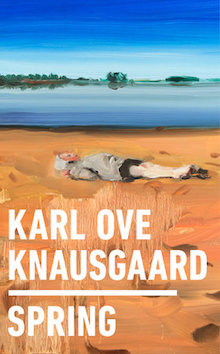
Spring by Karl Ove Knausgaard, translated from the Norwegian by Ingvild Burkey (Penguin)
First off: NAME THE TRANSLATOR. C’mon Penguin, you’re fooling exactly no one. Do you really believe that obscuring the fact that this was translated is going to help you sell more copies? It’s KARL ØVE KNAUSGAARD. Everyone buying this book is aware of two things: 1) he’s foreign, 2) his best books are long as fuck. (My Struggle: Book Six is out in September and is 1,100 pages long.) I suspect he tossed off these 192 pages while waiting in line at the local Kiwi grocery store.
Jacket copy:
Grade: C-
That opening is not very promising at all. If I wanted overwrought poetry, I’d grade some more student papers. Mostly though, I’m down-grading this for “fantastic,” “spellbinding,” “utterly gripping,” and especially “brilliantly rendered in Knausgaard’s famously sensitive, pensive, and honest style.” Sound like it’s important/insufferable.
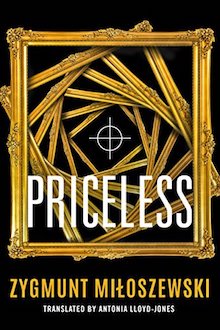
Priceless by Zygmunt Miłoszewski, translated from the Polish by Antonia Lloyd-Jones (AmazonCrossing)
I only have positive things to say about Miłoszewski and Antonia Lloyd-Jones–one of my favorite people to do drink Polish vodka with–and really hope that this book catches on. Not sure I like the cover though. It seems like it would work better if it was designed for a black light and came with some edibles.
Jacket Copy:
It begins with a tantalizing clue: a recent photograph taken of Raphael’s Portrait of a Young Man—one of the most priceless masterworks ever plundered by the Nazis, which disappeared and was believed destroyed. Now, with proof of its existence, the Polish government wants it back. One wrong move and it could vanish forever. Because bound together with the missing artwork are secrets that have remained buried for a reason.
That’s why they’ve enlisted a woman with the right motives: Dr. Zofia Lorentz, a tenacious historian driven by academic pride and personal desire. Zofia isn’t going at it alone. Her crack team of experts includes an ex-paramilitary tactical genius, a slick art dealer with black-market connections, and a beautiful aristocrat who is also a family outcast and one of the most ingenious art thieves in the world.
From an isolated mansion in New York to Poland’s Tatra Mountains to the frozen Scandinavian wilderness, they’re following the trail of an increasingly elusive puzzle—right into a trap that is a cunning work of art in itself.
Grade: B-
Oof. I was into this for the most part, but “because bound together with the missing artwork are secrets that have remained buried for a reason” is awkward, and “Zofia isn’t going at it alone” sounds like bad voiceover for a Hollywood movie. And “crack team of experts”?? I’m totally not the audience for this though. They’re writing these for casual readers who want books like movies.
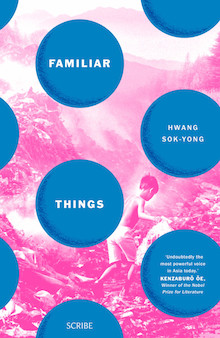
Familiar Things by Hwang Sok-Yong, translated from the Korean by Sora Kim-Russell (Scribe)
Of all the books on this particular list, I think this one–and the Knausgaard–are the ones really getting shafted on my “one week, one translation” scheme. I’m sure I’ll find time to catch up and read some 2018 translations “for fun” later this year, but for now I have to table both of these books. Although to be honest, I think my attraction to this book is because the cover is so god damn bright. It sits on the shelf by my desk SCREAMING.
Jacket Copy:
Seoul. On the outskirts of South Korea’s glittering metropolis is a place few people know about: a vast landfill site called Flower Island. Home to those driven from the city by poverty, is it here that 14-year-old Bugeye and his mother arrive, following his father’s internment in a government ‘re-education camp’.
Living in a shack and supporting himself by weeding recyclables out of the refuse, at first Bugeye’s life on Flower Island is hard. But then one night he notices mysterious lights around the landfill. And when the ancient spirits that still inhabit the island’s landscape reveal themselves to him, Bugeye’s luck begins to change – but can it last?
Vibrant and enchanting, Familiar Things depicts a society on the edge of dizzying economic and social change, and is a haunting reminder to us all to be careful of what we throw away.
Grade: C
Is this YA? I honestly can’t tell. I mean, “Bugeye”? Really? Sounds like a character in Riverdale. (Literal names of characters from Riverdale: Jughead, Jelly Bean, Papa Poutine, Small Fry, Archie.) The ancient spirits + very on-the-nose environmental message are why this seems to lead away from adult fiction into some sort of middle-grade fable. I have a feeling that it’s not, actually, but Flower Island and Bugeye? Well.
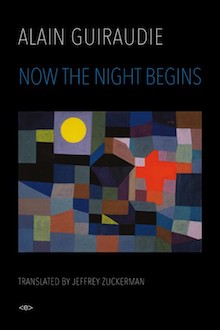
Now the Night Beings by Alain Guiraudie, translated from the French by Jeffrey Zuckerman (Semiotext(e))
Semiotext(e) plus Zuckerman is a good combination . . . But man, this cover. It’s like a Minecraft orgy.
Jacket Copy:
At the tail end of summer vacation, Gilles Heurtebise drifts between lazy afternoons, swimming, cruising the shores of a nearby lake, and absentmindedly hooking up with old lovers. He has yet to achieve material or romantic stability. He is forty, facing a precarious future with unformed fears and regrets. The one thing that seems solid is Grampa, the ninety-year-old patriarch of a family Gilles has befriended. Gilles grows obsessed by the old man, and a strange sexual bond grows between the two. When the police get involved, and Gilles is witness to a murder, the banality of interhuman violence is brought to a paroxysmal climax.
The winner of France’s prestigious Prix Sade, Now the Night Begins is a meditation on friendship, love, power, and abuse in a world where social relations have radically disintegrated. Interwoven with swaths of Occitan, the language of troubadours and love, and by turns hyperrealist and phantasmagoric, the novel recalls Georges Bataille’s dark surrealism and the unvarnished violence of Bret Easton Ellis. It proves Alain Guiraudie’s status as the preeminent writer of the vulnerability underlying our contemporary malaise.
Grade: A-
Now this is some interesting copy! Bataille, Bret Easton Ellis, a forty-year-old having some sort of mid-life reckoning (yeah, I know it’s close to home, you don’t need to remind me), a murder . . . Only dings are for “Grampa” (editing choice, sure, but I just don’t like that spelling) and the extra little literary spice of “swaths of Occitan” and “hyperrealist and phantasmagoric.”
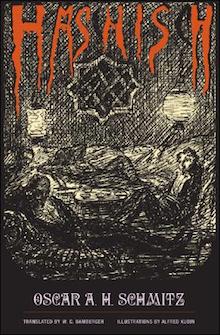
Hashish by Oscar Schmitz, translated from the German by W. C. Bamberger (Wakefield Press)
This is like taking Stanisław Ignacy Witkiewicz’s Narcotics to the next level. And who doesn’t like hashish? (Kidding! Totally, like, drugs are bad and make you crazy and shit.)
Jacket Copy:
First published in German in 1902, then reissued in 1913, Hashish is a collection of decadent interweaving tales of Satanism, eroticism, sadism, cannibalism, necrophilia, and death. Encountering the enigmatic blond dandy, Count Vittorio Alta-Carrara, in a Parisian eatery, the narrator finds himself invited to a “Hashish Club,” where in the dim light of red-filtered candles, a roomful of recumbent wanderers explores the abyss of the unconscious beneath the fabulous ponds of Venetian mirrors. The narrator and the Count don a variety of identities as they in turn enter the narratives, sometimes participating in them, other times merely observing them from the vantage point of a shifting divan. Engaging in romantic liaisons with masks and cadavers, taking part in Satanic orgies and carnivals, plotting blasphemy and riding carriages through cityscapes where time loses its bearings, the reader joins the protagonists in their narrative and psychological unmooring.
Grade: A
You had me at “Satanic orgies”?
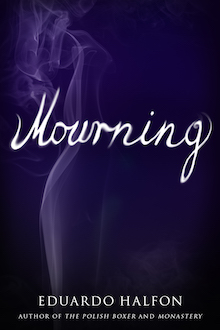
Mourning by Eduardo Halfon, translated from the Spanish by Lisa Dillman and Daniel Hahn (Bellvue Literary Press)
Is there another translation dream team on the level of Lisa Dillman and Danny Hahn? I can think of a lot of brilliant translator duos out there–Nick Caistor & Lorenza Garcia, Margaret Jull Costa & Robin Patterson–but, and I mean this in the best way possible, those pairings usually involve a mentor and a mentee. But Lisa and Danny? Both top level. Both very much sought after. Halfon has received a gift.
Jacket Copy:
In Mourning, Eduardo Halfon’s eponymous narrator travels to Poland, Italy, the U.S., and the Guatemalan countryside in search of secrets he can barely name. He follows memory’s strands back to his maternal roots in Jewish Poland and to the contradictory, forbidden stories of his father’s Lebanese-Jewish immigrant family, specifically surrounding the long-ago childhood death by drowning of his uncle Salomón. But what, or who, really killed Salomón? As he goes deeper, he realizes that the truth lies buried in his own past, in the brutal Guatemala of the 1970s and his subsequent exile to the American South.
Mourning is a subtle and stirring reflection on the formative and destructive power of family mythology, silence, and loss.
Grade: B
This feels like jacket copy I would write. (We’ll get to that, I promise.) It’s all totally fine, almost modest in its reservations. Penguin would never produce copy like this–not audacious and immediate enough.
Who killed Uncle Salomón? This pressing, explosive question is at the heart of Halfon’s necessary new novel, a book that unpacks a mystery spanning generations, and the world itself, from 1970s Guatemala to Poland and Halfon’s Lebanese-Jewish family. A heart-wrenching story about the danger of keeping secrets, Mourning is the most powerful novel of the year: a novel of loss, silence, and family mythology.
Being honest and subdued should get you more points. But we live in a YouTube reality and words don’t mean things anymore.
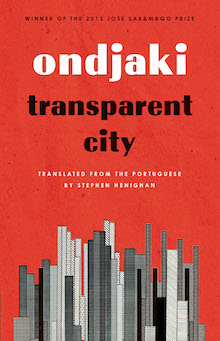
Transparent City by Ondjaki, translated from the Portuguese by Stephen Henighan (Biblioasis)
I totally dig this cover. Never been able to get into Ondjaki myself, but I would read this. It’s not as arresting as the Charco Press covers that I love, but I’m in.
Jacket Copy:
In a crumbling apartment block in the Angolan city of Luanda, families work, laugh, scheme, and get by. In the middle of it all is the melancholic Odonato, nostalgic for the country of his youth and searching for his lost son. As his hope drains away and as the city outside his doors changes beyond all recognition, Odonato’s flesh becomes transparent and his body increasingly weightless.
A captivating blend of magical realism, scathing political satire, tender comedy, and literary experimentation, Transparent City offers a gripping and joyful portrait of urban Africa quite unlike any before yet published in English, and places Ondjaki, indisputably, among the continent’s most accomplished writers.
Grade: B+
If there were more detail about how the “city outside his doors changes beyond all recognition,” I might give this a higher grade. It’s mysterious as is, but that + “weightless” + “magical realism” gives me pause.
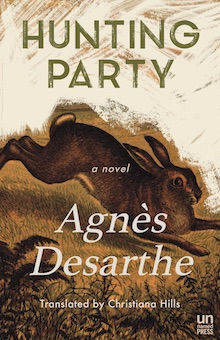
Hunting Party by Agnès Desarthe, translated from the French by Christiana Hills (Unnamed Press)
I’ll be honest: I’m putting this on the list mainly because I think the Unnamed Press editors (Chris & Olivia) are fucking baller. They’re like the sister press to Phoneme (there’s probably a proper way to explain this connection, but I don’t know it and I’m writing this in the bathroom, since Aleksandrs, my two-month-old, will only not-scream from being gassy if he’s sleeping on his changing pad, and babies are great, and where was I) and we all had a great time at the LA Times Festival of Books. Marketing is all about one-to-one relationships. So what is this books about? The cover isn’t that illuminating, and maybe not Unnamed’s best, but still.
Jacket Copy:
Cajoled into going by his wife, who is anxious to ingratiate herself with the locals of their new village, Tristan’s companions are Pastis-swilling tough guys with designs beyond catching dinner.
Gentle, reflective Tristan has no intention of killing anything, so when his shot inadvertently grazes a rabbit, he saves the animal and hides it in his bag before the others notice. Tristan soon finds himself deeply connected to the wounded rabbit, whose voice comes alive to share its wisdom with the young man.
Suddenly, the weather turns and a terrible storm descends upon the party, as well as their village. In the valley below, the rushing water exposes the close-knit community’s secrets and indiscretions, while Tristan and the rabbit must confront something far worse.
Grade: C+
Does the rabbit talk?. If so, then F. For the book, I suppose, and not necessarily the jacket copy. Man, I can not stand books with talking animals. And you’ll never convince me that a talking animal book can be good. You can try, but in the end, it’s a fucking talking bear or dog or rabbit and that’s 100% dumb.
However I am a fan of “cajoled” and “Pastis-swilling tough guys,” because is there anything more French than that?
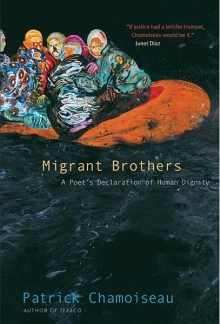
Migrant Brothers by Patrick Chamoiseau, translated from the French by Linda Coverdale (Yale University Press)
Chamoiseau’s Texaco was one of the few translations we had at Quail Ridge Books when I first started there. QRB eventually won “Bookstore of the Year” from Publishers Weekly, partially because of their international lit section, but that was a bit of an expansion. Back in 1999, I assumed Chamoiseau was a household name because of Texaco and I was wrong. I remember thinking the same thing about Roberto Bolaño (more likely!) years later and then dropping his name all casually at a bar and realizing that I’m a moron and our industry is both omnipresent and hyperspecific all at once.
Jacket Copy:
As migrants embark on perilous journeys across oceans and deserts in pursuit of sanctuary and improved living conditions, what is the responsibility of those safely ensconced in the nations they seek to enter? Moved by repeated tragedies among immigrants attempting to enter eastern and southern Europe, Patrick Chamoiseau assails the hypocrisy and detachment that allow these events to happen. Migrant Brothers is an urgent declaration of our essential interconnectedness that asserts the necessity to understand one another as part of one human community, regardless of national origin.
Grade: D
The book sounds great! But all this overblown verbiage–“an urgent declaration of our essential interconnectedness” and “perilous journey” and “safely ensconced”–is a big turn-off. An academic book pitched to academics is like preaching to the choir squared.
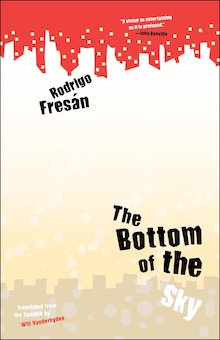
The Bottom of the Sky by Rodrigo Fresán, translated from the Spanish by Will Vanderhyden (Open Letter Books)
I think this is the first time an Open Letter title has been included in one of my weekly missives. With saintly bias, I love Fresán’s work, and want him to surpass everyone else on this list and be read by everyone who ever even thought about picking up a Knausgaard or Ferrante book. Which is why I’m terrified to reproduce the jacket copy . . . On one of the episodes of the Two Month Review, Brian Wood and I rewrote the jacket copy for The Invented Part using rules from some “How to Be a Successful Writer” book. And we crushed it. Obviously. I forget the details, but there was basically a formula to the whole thing: “[Main Character] is a [job/activity of interest] who [main plot point] until [introduce conflict].” So easy! That’s how you get an A!
Jacket Copy:
An homage to American science-fiction films and novels, The Bottom of the Sky is the story of two boys, a disturbingly beautiful girl, and their joint love for other planets. Their friendship is formed during the heyday of sci-fi writing, a time defined by almost cult-like literary groups and pulp covers awash in gaudy alien landscapes. But time has passed, and the three members of The Faraways have drifted apart. The future they once dreamed of is now happening, but interstellar travel to Urkh 24 has been replaced with 9/11, the Gulf War, and a mysterious “incident” at the center of it all.
A Kurt Vonnegut novel told by David Lynch, filtered through the madness of Philip K. Dick, The Bottom of the Sky is a triumph of style, or, as Fresán says in the afterword, “a clump of simultaneously broadcast messages, like a storyline that only wants to be a succession of marvelous moments seen all at the same time.”
Grade: Z
This book is so much better than our copy. All these books transcend their copy. Judge a book by its cover, I guess?, instead of by its collaboratively written description.

[…] May Is a Month of Grading […]